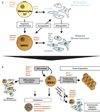Cancer stem cells and human malignant melanoma
- PMID: 18353142
- PMCID: PMC2885609
- DOI: 10.1111/j.1755-148X.2007.00427.x
Cancer stem cells and human malignant melanoma
Abstract
Cancer stem cells (CSC) have been identified in hematological malignancies and several solid cancers. Similar to physiological stem cells, CSC are capable of self-renewal and differentiation and have the potential for indefinite proliferation, a function through which they may cause tumor growth. Although conventional anti-cancer treatments might eradicate most malignant cells in a tumor, they are potentially ineffective against chemoresistant CSC, which may ultimately be responsible for recurrence and progression. Human malignant melanoma is a highly aggressive and drug-resistant cancer. Detection of tumor heterogeneity, undifferentiated molecular signatures, and increased tumorigenicity of melanoma subsets with embryonic-like differentiation plasticity strongly suggest the presence and involvement of malignant melanoma stem cells (MMSC) in the initiation and propagation of this malignancy. Here, we review these findings in the context of functional properties ascribed to melanocyte stem cells and CSC in other cancers. We discuss the association of deregulated signaling pathways, genomic instability, and vasculogenic mimicry phenomena observed in melanoma subpopulations in light of the CSC concept. We propose that a subset of MMSC may be responsible for melanoma therapy-resistance, tumor invasiveness, and neoplastic progression and that targeted abrogation of a MMSC compartment could therefore ultimately lead to stable remissions and perhaps cures of metastatic melanoma.
Figures

References
-
- Balazs M, Adam Z, Treszl A, Begany A, Hunyadi J, Adany R. Chromosomal imbalances in primary and metastatic melanomas revealed by comparative genomic hybridization. Cytometry. 2001;46:222–232. - PubMed
-
- Balch CM, Soong SJ, Gershenwald JE, et al. Prognostic factors analysis of 17,600 melanoma patients: validation of the American Joint Committee on Cancer melanoma staging system. J. Clin. Oncol. 2001;19:3622–3634. - PubMed
Publication types
MeSH terms
Substances
Grants and funding
LinkOut - more resources
Full Text Sources
Other Literature Sources
Medical

